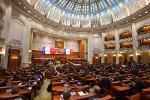BRD-SocGen, the second-largest bank on the market, made net profit of 168 million RON (around 51 million euros) in the first quarter, up 12% on the same time last year. However, the return on equity (ROE) fell, from 35% in the first quarter of 2006, (and for the entire of last year) to 30% in Q1, 2007. "It was a satisfactory start to the year," Patrick Gelin, chairman and chief executive of BRD-SocGen told ZF.
He believes all indicators are following "a positive trend", in line with this year's plan. The only exception is the exchange rate, which is already lower than the budgeted rate.
The volume of loans increased by 78% against March 31, 2006 totalling 19 billion RON (5.75 billion euros), whereas the retail lending almost doubled, and corporate lending increased by 64%.
The deposits attracted continue to exceed the volume of loans, totalling 20 billion RON, an increase of 36% on the same period in 2006. Gelin says that the BRD remains relatively aggressive in its policy of attracting deposits, in order to sustain sound growth of lending, especially on the segment of small and medium-sized enterprises.
With all the attempts to stimulate customers to deposit money for longer terms (at least one year), around 85% of the deposits attracted by the BRD are made on terms of one to three months.
"We have to continue to attract resources," says Gelin, highlighting the recent shortage of cash on the monetary market.
He adds that the BRD, like the entire banking market, has continued to bear the effect of narrowing interest margins. "The margin has continued to decrease, although not as fast as last year's rate, nearing four percentage points. It may go down even further, but no less than a 3-3.5 percent minimum," Gelin stated.
He says that the first quarter witnessed a slowdown in consumer lending, compared with last year, whic



